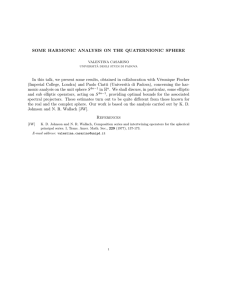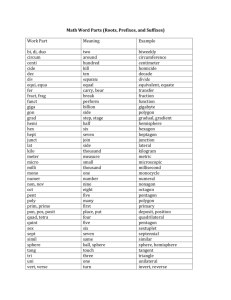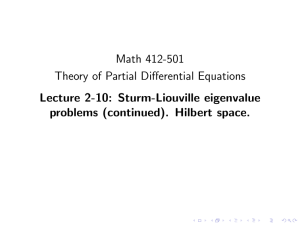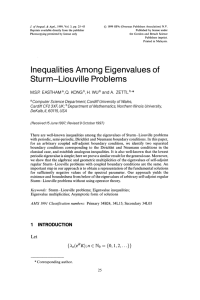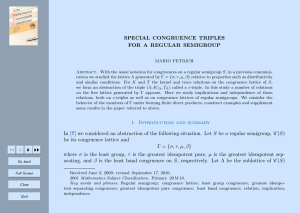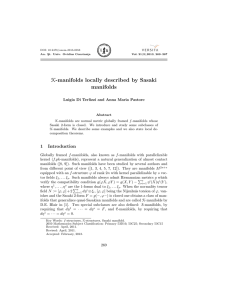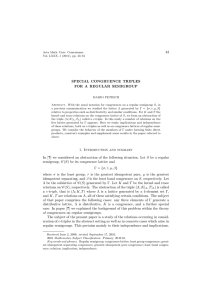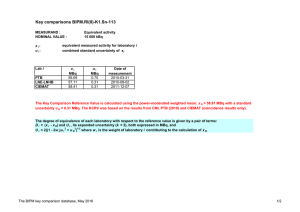Dirac Equations with Singular Potentials Shell interactions for Dirac operators:
advertisement
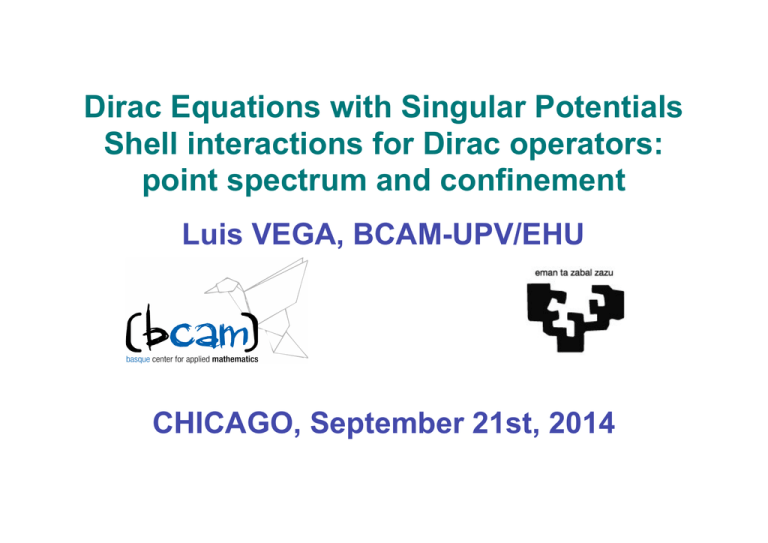
Dirac Equations with Singular Potentials
Shell interactions for Dirac operators:
point spectrum and confinement
Luis VEGA, BCAM-UPV/EHU
CHICAGO, September 21st, 2014
Free Dirac operator in R3
Definition.– H : Cc1 (R3 )4 ! Cc1 (R3 )4 free Dirac operator in
R3 ,
0
m
0
i@3
@2 i@1
B
0
m
@2 i@1
i@3
H = i↵·r+m = B
@
i@3
@2 i@1
m
0
@2 i@1
i@3
0
m
Remarks.–
• 1st order symmetric di↵erential operator.
p
• Local version of
+ m2 : H 2 = (
• Dirac (1928)
+ m2 )I4 .
1
C
C.
A
Coupling with a singular potential
First Question.–
⌦ ⇢ R3 bounded regular domain,
⌃ = @⌦,
surface measure on ⌃,
V potential L2 ( )4 -valued.
To find D ⇢ L2 (R3 )4 such that H + V defined on D is self-adjoint.
Motivation.–
• Quantum Physics requires self-adjointness.
•
critical (scaling) for H,
| | < 1 (Dolbeault, Esteban,
Sere, ’00; Hardy Inequality, Uncertainty Principle).
|x|
• H+ |x|=1 (and other critical V ’s on S 2 ) (Dittrich, Exner &
Seba ’89; Spherical Harmonics. Albeverio, Gesztesy, HoeghKrohn & Holden ’88 -’05).
• Previous results on
critical/Critical.
+
⌃
for Lipschitz surfaces ⌃. Sub-
Initial Approach
First Question.–
To find D ⇢ L2 (R3 )4 such that H + V defined on D is self-adjoint.
Our Approach.–
Take ' 2 D,
V potential L2 ( )4 -valued =) V (') = g for some g 2 L2 ( )4 .
(H+V )(') 2 L2 (R3 )4 =) (H+V )(') = G for some G 2 L2 (R3 )4 .
H(') = G + g in the sense of distributions.
Therefore
'=
⇤ (G + g)
and
(H + V )(') = G,
V (') =
g,
is the fundamental solution of H = i↵ · r + m ,
✓
◆
m|x|
e
x
(x) =
m + (1 + m|x|) i↵ · 2
for x 2 R3 \ {0}.
4⇡|x|
|x|
where
Self-adjointness of H + V
Property.– If G 2 L2 (R3 )4 , then
( ⇤ G)|⌃ 2 L2 ( )4 .
⇤ G 2 W 1,2 (R3 )4 and
Theorem (Self-adjointness).– Given ⇤ : L2 ( )4 ! L2 ( )4
bounded, self-adjoint and with closed range, define
D=
⇤ (G + g) : ( ⇤ G)|⌃ = ⇤(g) ⇢ L2 (R3 )4 .
If V
⇤ (G + g) =
self-adjoint.
g, then H + V defined on D is essentially
Remarks.–
• Under more assumptions on ⇤, H + V is self-adjoint. Posilicano ’08-’09.
• Other di↵erential operators and measures are considered.
• Other relations between ( ⇤ G)|⌃ and g are considered.
Resolvent of H
Resolvent.– Given a 2 ( m, m), let
tion of H a = i↵ · r + m
a,
a
(x) =
e
p
m2 a2 |x|
4⇡|x|
✓
⇣
a+m + 1+
a
be the fundamental solu-
p
m2
a2 |x|
⌘
x
i↵ · 2
|x|
◆
.
Our Setting.– ⌦+ ⇢ R3 bounded regular domain, ⌦ = R3 \ ⌦+ ,
⌃ = @⌦± , surface measure on ⌃, N normal vector on ⌃ w.r.t.
⌦+ .
Properties.– If g 2 L2 ( )4 , then (H
x 2 ⌃, set
a
C±
g(x) =
lim (
a
nt
⌦± 3y !x
⇤ g)(y),
a)(
a
⇤ g) = 0 in ⌃c . For
C a g(x) = p.v. (
a
⇤ g)(x).
Then,
a
= ⌥ 2i (↵ · N ) + C a
• C±
• C a (↵ · N )
2
=
1
4.
(Plemelj-Sokhotski jump formulae),
Point spectrum and confinement for H + V
Our Setting.– Set D = ' = ⇤ (G + g) : ( ⇤ G)|⌃ = ⇤(g)
and H + V : D ⇢ L2 (R3 )4 ! L2 (R3 )4 defined by V (') = g and
(H + V )(') = G for ' 2 D.
Our Theorem (Point Spectrum).– Given a
Ker (H + V a) 6= ; i↵ Ker (⇤ + C
C a ) 6= ;.
2
( m, m),
Point spectrum and confinement for H + V
Definition.– V generates confinement w.r.t. H and ⌃ i↵
supp e it(H+V ) (f ) ⇢ ⌦± for all f 2 L2 (⌦± )4 and all t 2 R.
This is equivalent to require that ⌦± ' 2 D for all ' 2 D.
Theorem (Confinement).– Assume that H + V is self-adjoint
on D.
Then, V generates confinement w.r.t. H and ⌃ if
{C (↵ · N ), ⇤(↵ · N )} =
(⇤(↵ · N ))2 .
Some applications.
Electrostatic shell potentials
Theorem.– Let 2 R \ {0} and a 2 ( m, m).
Take ⇤ = (1/ + C ), D = ' = ⇤ (G + g) : ( ⇤ G)|⌃ = ⇤(g) ,
and V (') = 2 ('+ + ' ) ('± n.t. boundary values of ' on ⌃).
• H + V defined on D is self-adjoint for all
• Ker (H + V
6= ±2.
a) 6= ; i↵ Ker (1/ + C a ) 6= ;.
• H +V and H +V
4/
have the same eigenvalues in ( m, m).
• If | | 62 [1/kC a k, 4kC a k], then Ker (H + V
a) = ;.
• If | | 62 [1/C, 4C], where C = supa2( m,m) kC a k < 1, then
H + V has no eigenvalues in ( m, m).
Theorem.– Let H + V be as above. If ⌦
H + V has no eigenvalues in R \ [ m, m].
is connected, then
Some applications.
Electrostatic plus Lorentz scalar shell potentials
Theorem.– Let
⇤=
s
2
e
e
2
s
e,
s
2 R be such that
2
e
2
s
6= 0, 4. Take
C ,
D = ' = ⇤ (G + g) : ( ⇤ G)|⌃ = ⇤(g) , and
Ves (') = 12 ( e + s )('+ + ' ) ('± n.t. boundary values of ').
• H + Ves defined on D is self-adjoint.
• Ves generates confinement w.r.t H and ⌃ i↵
2
e
2
s
=
4.
Some applications.
Electrostatic plus Lorentz scalar shell potentials
Remarks.–
• That Ves generates confinement means that the particles
modelized by the evolution @t + i(H + Ves ) never cross ⌃
over time, i.e., ⌃ becomes impenetrable.
2
• The impenetrability condition 2e
4 was known for
s =
⌃ = {x 2 R3 : |x| = R}, R > 0 (Dittrich-Exner-Seba).
Uncertainty Principle on the sphere S 2
We focus on H + V for ⌃ = S 2 = {x 2 R3 : |x| = 1}
Definition.– Let e = ( 1 ,
Given a 2 ( m, m), define
k a (x) =
wa (x) =
e
p
2,
m2 a2 |x|
4⇡|x|
e
p
m2 a2 |x|
4⇡|x|3
3)
be the family of Pauli matrices.
I2
and
⇣
p
For f 2 L2 ( )2 and x 2 S 2 , set
1+
m2
⌘
a2 |x| i e · x.
K a f (x) = (k a ⇤ f )(x) and W a (f ) = p.v.(wa ⇤ f )(x).
Uncertainty Principle on the sphere S 2
Remarks.–
• K a and W a are bounded operators in L2 ( )2 .
• K a is a positive operator.
Uncertainty Principle on the sphere S 2
Theorem.– Let
> 0 and a 2 ( m, m). The operator
1/ + (m + a)K a
is invertible in L2 ( )2 .
Furthermore, for any f 2 L2 ( )2 and any > 0,
Z
Z
1
1
2
|f | d
(1/ + (m + a)K a ) (W a (f )) · W a (f ) d
2M S 2
S2
Z
+
(1/ + (m + a)K a ) ((e · N )f ) · (e · N )f d ,
2M S 2
(1)
where M is a constant
depending
only on m and a.
p
p
p
1
m 2 a2
m 2 a2 .
2
Moreover, M
e
2
e
2
For suitable ’s, the inequality (1) is sharp and the equality can be
attained.
Uncertainty Principle on the sphere S 2 .
Consequences
Definition (2-dimensional Riesz transform).– Given a finite
Borel measure ⌫ in R3 , h 2 L2 (⌫) and x 2 R3 , one defines the
2-dimensional Riesz transform of h as
Z
x y
R⌫ (h)(x) = lim
h(y) d⌫(y),
3
✏&0 |x y|>✏ |x
y|
whenever the limit makes sense.
Uncertainty Principle on the sphere S 2 .
Consequences
Corollary.– 2⇡khkL2 ( ) kR (h)kL2 ( )3 for all real-valued h 2
L2 ( ), and the inequality is sharp.
Hofmann, Marmolejo-Olea, Mitrea, Pérez-Esteva, & Michael Taylor ’09
• For suitable elections of , a, and , the minimizers of (??)
give rise to eigenfunctions of H + V with eigenvalue a.
• The set of ’s for which H +V has a non-trivial eigenfunction
contains an interval.
THANK YOU FOR YOUR
ATTENTION
